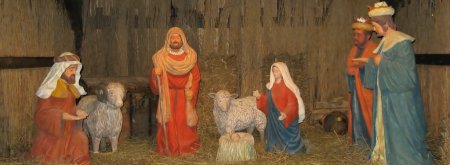Was There Really a Star of Bethlehem?
A remarkable thing happened in the UK in the week before Christmas 2010. Four 30-minute programmes dramatising the Nativity were shown by the BBC on prime-time television. The script was written by Tony Jordan, an award-winning script writer, and some 4 million people watched each episode.
The writer described his work on it as a life-changing experience. He started from a position of scepticism and interviewed various scholars in his research, who apparently down-played the credibility of the story. He, in contrast, became increasing convinced that it had happened. 'You know the truth when you hear it', he said. The resulting film was a compelling, moving and indeed, beautiful piece of work.
One area he previously knew little or nothing about was the story of the wise men, which became a particular subject for his research. As a whole window opened up for him, so it did for the viewer. Here was a romantic part of the story that suddenly became entirely credible.
Just a charming story?
Years ago I used to skip over the story of the wise men. Told in the first eighteen verses of Matthew Chapter 2, it is a charming enough tale but it seemed to me to be fraught with difficulties. Why would astrologers in the east be remotely interested in a ‘king of the Jews’? Why should they set out on such a vast journey? How can a star move across the sky out of sync with all the other stars? If the star was in the east, how come it led them to the west? How could it stop directly over a stable, thereby identifying the place where Christ was born? And why should Herod then set out to kill all the boys in Bethlehem aged two and under?
Why would astrologers in the east be remotely interested in a ‘king of the Jews’?
Of course the story in most people’s minds has grown more complex with mythical accretions, which suit the needs of carols and children’s pageants but remove it from the sphere of critical analysis. So we are neither told by Matthew that these men were kings (but rather, ‘wise men’) nor that there were three of them (it was three gifts, not three people!) and of course their names were not recorded. Neither did the star identify the precise location of the birth nor did their visit coincide with the shepherds.
We need to realise that while astrology today is a matter of fatuous absurdity, we do not have to go far back in history to find that serious astronomy and the quest to understand the significance of the stars were not separate ‘disciplines’. There is a very long history of serious people documenting the movements of the stars and reading significance into them. Chinese, Korean and Babylonian astrologers have left detailed records of their ancient observations.
One thing the television didn’t mention was the reason why Babylonian scholars would have been interested in Judea. The dispersion of the Jews took place from the eighth century BC, widely scattering vast numbers of Jews. However, only 600 years before Christ, hundreds of Jews from the Southern Kingdom, including their most talented people, were exiled from Jerusalem specifically to Babylon and many stayed there indefinitely. So Judaism was well established in Babylon. Daniel’s answer to King Nebuchadnezzar’s dream indicates the intellectual resources available to the King at the Babylonian Court. 'No wise men, enchanters, magicians, or astrologers can show to the king the mystery that the king has asked' (Daniel 2:27). And Babylon, of course, is some 550 miles due east of Judea.
While there is on-going dispute about the year of Christ’s birth, it is generally conceded that Herod the Great died at Jericho in the spring of 4 BC. So a good case can be made out for Christ’s birth occurring as early as 5 BC.
What was the star?
There seem to be three main ways of interpreting the 'star' – a conjunction of planets; a comet, nova or supernova; or an entirely miraculous phenomenon. The TV film went for the first option, the conjunction of the planets Jupiter and Saturn. Such an event happened in 7 BC and would certainly have attracted great attention from oriental astrologers.[1] If they had associated a world ruler with Jupiter and Israel with Saturn, which is thought possible, combined with what they knew of the promised Messiah, including the promise of a star (Numbers 24:17ff), they might well have been watching the skies expectantly for two years before the birth of Christ.
Contrary to popular mythology, Matthew does not actually say they followed the star
If the 7 BC conjunction initiated their interest, a comet however might have been the ‘star’ that continued it and was recorded by Matthew. Such a tailed comet was recorded by Chinese and Korean stargazers in about 5 BC. This object was observed for over seventy days though it did not appear to move. Expecting ‘a star of Jacob’ to herald the birth of a new Jewish ruler 'we saw his star when it rose' (Matthew 2:2), this comet may have fulfilled their expectations and triggered their long journey to Jerusalem, lasting for its duration of several weeks. Contrary to popular mythology, Matthew does not actually say they followed the star. Rather, its appearance initiated their journey (verse 2). Their need was first of all to go to Jerusalem to ask where the new king of the Jews was to be found. There was no problem for the chief priests and teachers there to agree that Bethlehem was the prophesied location (Micah 5:2).
The character of Herod
Herod was concerned to find out the exact time the star had appeared (verse 7). They said they saw it arise in the east and presumably they would have mentioned the planetary conjunction two years earlier, which gave meaning to the current astrological phenomenon. Herod, the paranoid and violent King of the Jews, was hedging his bets to cover all possibilities, making his calculations 'according to the time that he had ascertained from the wise men' (verse 16).
In killing all boys under two, Herod was merely doing what Herod did. The first century Jewish historian Josephus does not record this particular atrocity – the slaughter of perhaps two or three dozen children – but gives a chilling appraisal of the man, calling him 'a pitiless monster”' He was accused by his contemporaries of being 'the most savage tyrant that had ever lived. Vast numbers were executed by him and the survivors had suffered so horribly that they envied the dead.' He had apparently tortured whole cities. His son and successor Archelaus continued the family tradition in 4 BC, inaugurating his reign by putting 3,000 citizens to death and filling the Temple with their bodies.[2] The murders in Bethlehem were of minor importance by comparison.
A credible explanation
The ‘star’ of 5 BC stayed brightly over head. It did not lead the Magi to Jerusalem in any direct sense (verse 2). Nor did they need its guidance for the final leg of their journey, as Bethlehem is only six miles from Jerusalem. The fact that we are told it went ahead of them at this point (verse 9) would imply that it was towards the south and consequently remained in view as they set out from Jerusalem. Contrary to the myth, we are not told that the star identified the house where the child was to be found, only that it 'came to rest over the place', i.e. the sky over that region (verse 9). They went to Bethlehem because of Micah's prophecy, not the guidance of the star!
Bethlehem would have been a very small town in those days, and if the story of the shepherds and their vision of angels was true, there would have been a great deal of local interest in the child (modern visions seem to attract tourist attention, which continues for years afterwards, eg. Medjugorje). The story seems to make clear that the child had already been born (verses 9 and 11) and is referred to as a child not a baby (further grounds for Herod’s doubts about his age).
Finally, the idea of a comet could explain the statement that the star stood 'over the place'. Ancient writers described comets as 'hanging over' specific cities. If the comet’s tail was pointing downwards, this would appear to have been dramatically the case. Josephus records that in 12 BC a comet (Halley’s) stood for several days over the city of Rome before the death of Marcus Agrippa. Another comet he records, stood over Jerusalem – perhaps the one mentioned by Tacitus in AD 64.
We haven’t got all the answers to our questions about the visit of the Magi, but by combining the known conjunction of the planets in 7 BC to give an interpretation of the meaning of the comet of 5 BC, along with the ancient prophecy about the star of Jacob, we have enough possibilities to make this colourful story entirely credible.
References
[1] Colin Humphreys, 'The Star of Bethlehem', Science and Christian Belief 5(2), 83-101, October 1993. Reprints available from Christians in Science.
[2] Josephus, The Jewish War. Penguin Classics 1981. pp.128ff.


